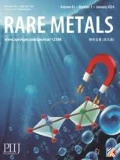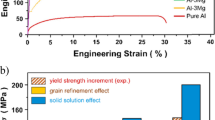Abstract
The ADC12 aluminum alloy is prone to severe tool wear and high cutting heat during high-speed milling because of its high hardness. This study analyzes the high-speed milling process from the perspective of different chip morphologies. The influence of cutting temperature on chip morphology was expounded. A two-dimensional orthogonal cutting model was established for finite element analysis (FEA) of high-speed milling of ADC12 aluminum alloy. A theoretical analysis model of cutting force and cutting temperature was proposed based on metal cutting theory. The variations in chip shape, cutting force, and cutting temperature with cutting speed increasing were analyzed via FEA. The results show that, with the increase in cutting speed, the chip morphology changes from continuous to serrated, and then back to continuous. The serrated chip is weakened and the cutting temperature is lowered when the speed is lower than 600 m·min−1 or higher than 1800 m·min−1. This study provides a reference for reducing cutting temperature, controlling chip morphology and improving cutting tool life.
Graphic abstract










Similar content being viewed by others
References
Zhang YF, Luo QG, Ma XP. Development status of several high power density engines of armored vehicles. Veh Power Technol. 2006;28(3):60.
Yang SL, Shen J, Zhang YA, Li ZH, Li XW, Huang SH, Xiong BQ. Processing maps and microstructural evolution of Al–Cu–Li alloy during hot deformation. Rare Met. 2019;38(12):1136.
Dursun T, Soutis C. Recent developments in advanced aircraft aluminium alloys. Mater Des. 2014;35(56):862.
Guo C, Li BM, Zhang HT, Cui JZ. Research status and development trend of high-strength and corrosion-resistant 5xxx series aluminum alloy. Rare Met. 2018;37(8):878.
Sui YD, Wang QD. Development of heat-resistant cast aluminum alloy for engine applications. Mater Rev. 2015;29(2):14.
Zheng HT. Application and prospect of lightweight material for automobile engine. Sci Technol Inf. 2015;13(9):233.
Zhang TH, Zhang LF, Fang YL. A cylinder liner of a high silicon rare earth aluminum alloy automobile engine. China Patent, 101949337.A. 2011.
Chen DH, Jia XL, Zhu XR. Research progress of cast aluminum alloy for engine cylinder head. Cast Tech. 2010;31(7):882.
Li XX. Design and research of EG01 engine lower cylinder block processing technology. Mach Manuf. 2012;50(10):63.
He YR, Cong M, Bi JY. High speed milling stability experiment research on ADC12 aluminum alloy. Modul Mach Tool Autom Manuf Tech. 2014;56(12):10–18.
Dwivedi DK. Adhesive wear behaviour of cast aluminium-silicon alloys: overview. Mater Des. 2010;31(5):2517.
Rahaman ML, Zhang L. An investigation into the friction and wear mechanisms of aluminium high silicon alloy under contact sliding. Wear. 2017;61(376–377):940.
Alshmri F, Atkinson HV, Hainsworth SV, Haidon C, Lawes SDA. Dry sliding wear of aluminium-high silicon hypereutectic alloys. Wear. 2014;313(1–2):106.
Balalan Z, Gulan F. Microstructure and mechanical properties of Cu-B4C and CuAl-B4C composites produced by hot pressing. Rare Met. 2019;38(3):1169.
Huang YL. Study on the Stability and Quality of High Speed Milling of Thin Wall Parts. Nanjing: Nanjing Univ Sci Technol; 2015. 1.
Umbrello D. Finite element simulation of conventional and high speed machining of Ti6Al4V alloy. J Mater Process Technol. 2007;196(1):79.
Tan L, Yao CF, Zuo W, Wu DX. Simulation on cutting temperature during high-speed milling aluminum alloy 7055. Appl Mech Mater. 2013;10(328):486.
Johnson GR, Cook WH. A constitutive model and data for metals subjected to large strains, high strain rates and high temperatures. In: Proceedings of the 7th international symposium on ballistics. The Hague. 1983. 541.
Shi J, Liu CR. The influence of material models on finite element simulation of machining. J Manuf Sci Eng. 2004;126(4):849.
Liang R, Khan AS. A critical review of experimental results and constitutive models for BCC and FCC metals over a wide range of strain rates and temperatures. Int J Plast. 1999;15(9):963.
Johnson GR, Cook WH. Fracture characteristics of three metals subjected to various strains, strain rates, temperatures and pressures. Eng Fract Mech. 1985;21(1):31.
Sun HL, Li D, Zhao FF. Two-dimensional simulation of aerospace 7075 aluminum alloy cutting based on ABAQUS. J Tianjin Polytech Univ. 2017;36(1):83.
Wang LY, Huang HH, Xie ZJ. Study on high speed machining and milling force of thin-walled aerospace aluminum alloy parts. J Central South Univ Nat Sci Ed. 2017;48(07):1756.
Rao B, Shin YC. Analysis on high-speed face-milling of 7075-T6 aluminum using carbide and diamond cutters. Int J Mach Tools Manuf. 2001;41(12):1763.
Jomaa W, Mechri O, Lévesque J. Finite element simulation and analysis of serrated chip formation during high–speed machining of AA7075–T651 alloy. J Manuf Process. 2017;22(26):446.
Atlati S, Haddag B, Nouari M. Analysis of a new Segmentation Intensity Ratio “SIR” to characterize the chip segmentation process in machining ductile metals. Int J Mach Tools Manuf. 2011;51(9):687.
Bi JY, Cong M, Liu D. Cutting simulation and test analysis of ADC12 Al–Si alloy. Comb Mach Tools Autom Process Technol. 2017;59(1):127.
Hu Y, Xiao Y, Jin X. Experiments and FEM simulations of fracture behaviors for ADC12 aluminum alloy under impact load. Met Mater Int. 2016;22(6):1015.
Merchant ME. Mechanics of the metal cutting process, I, orthogonal cutting and a type 2 chip. J Appl Phys. 1945;16(5):267.
Oxley PLB, editor. The Mechanics of Machining: An Analytical Approach to Assessing Machinability. Chichester: British Library Cataloguing in Publication Data; 1989. 1.
Lazoglu I, Altintas Y. Prediction of tool and chip temperature in continuous and interrupted machining. Int J Mach Tools Manuf. 2002;42(9):1011.
Acknowledgements
This study was financially supported by the National Natural Science Foundation of China (No. 51975123) and Fuzhou Science and Technology Plan Project (No. 2019G42).
Author information
Authors and Affiliations
Corresponding author
Rights and permissions
About this article
Cite this article
Meng, XX., Lin, YX. Chip morphology and cutting temperature of ADC12 aluminum alloy during high-speed milling. Rare Met. 40, 1915–1923 (2021). https://doi.org/10.1007/s12598-020-01486-2
Received:
Revised:
Accepted:
Published:
Issue Date:
DOI: https://doi.org/10.1007/s12598-020-01486-2



